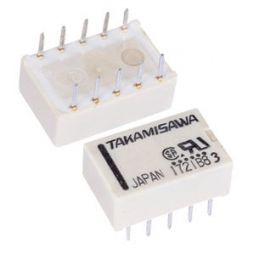Just to add some more color to what others have said: while I haven't personally had any reliability issues with mechanical 3PDT foot switches, I've seen people with substantially more experience than me complain about the reliability of those switches versus relays. The manufacturer's reliability numbers tell it pretty plain and simple: relays are typically rated for
millions of switches, but the mechanical 3PDT are 10s of thousands (unless you spring for that expensive 200k-rated one LMS sells). Furthermore, what I've gathered from internet hearsay is that the numbers assume ideal conditions: if you take too long soldering wires (or a PCB) to your switch, you could degrade the epoxy that holds it together, further reducing the expected lifespan. (I would assume this holds true for relays as well; but the ones I've used have tiny pins that solder up super quickly, so heat exposure time "should" be less.)
I haven't checked the life expectancy numbers of the SPST momentary switches that are typically used as the "user interface" to relay bypass. However, they "should" be better, because they are a much simpler design. And even if they do fail, they have only two wires, so they are trivial to replace; those wires don't carry signal, so you can be generous with the wire length so they can be easily swapped if necessary.
The relay bypass decouples the user-interface (i.e. the SPST momentary footswitch) from the actual signal switching mechanism (i.e. the relay). The mechanical 3PDT switch combines those two functions. (Maybe it's because I'm a lifelong Linux user I'm naturally drawn to the Unix philosophy of many simple tools that do a single thing very well, versus fewer multi-function tools!) The by-product of this decoupling is that, depending on what you put between the foot switch and the relay, you can open yourself up to additional utility. E.g., you can implement a mute circuit that activates a moment before the signal is switched and a moment past; you can implement momentary (press-and-hold) on/off; you can have a double-tap do some function... Furthermore, with the mechanical 3PDT, every time you switch, there is some degree of mechanical stress from your foot; you're quite literally stomping on a device that carries signal. With relay bypass, the actual signal-switching device is more insulated from your foot.
Another perk of relay bypass, which is a direct result of decoupling the footswitch from the actual signal switching, is that, if you are designing custom PCBs, it greatly simplifies the offboard wiring, and can shorten overall signal-carrying wire lengths. If you think about a typical DIY pedal in a 125B, you have signal wire coming from the top of the enclosure (at the input/output jacks) all the way down to the 3PDT footswitch, and back again. If you have a few pedals like this, you've essentially increased the length of the cable between guitar and amp. It might not be a problem, but added wire length is another
potential problem (maybe you need a buffer after all). Whereas, when I design custom PCBs with integrated relay bypass, I try to put the relay as close to the top of the PCB as possible. Offboard wiring is my least favorite part of pedal building, so this approach also saves a few wires.
Ultimately, I think it's mostly personal preference. I do think there's a legitimate reliability argument to be made; but if you're a pedalholic and have enough pedals that many go long periods of time without being used, then that argument is weakened. Relay bypass is decidedly more complex and typically more expensive. Non-latching relays require a constant current draw in one position (i.e. the relay itself might use more power than e.g. a simple overdrive circuit).
Finally, my shameless plug:
my relay bypass project writeup here on PPCB forums, and the
corresponding project on GitHub.

